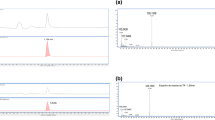Abstract
Three interesting new compounds formed as a result of phenols-iodine redox reactions were investigated by mass spectral fragmentation (MS) and thermal analyses (TA) as well as some other physicochemical methods as microanalysis and infra-red spectroscopy to elucidate their structures. The characterization of the compounds was satisfactorily achieved by using the above analytical tools and their proposed general formulae, were found to be C24H15O8I (PC-IO −3 ), C24H14O12 I2 (PG-IO −3 ) and C12H8O6I2 (PG-IO −4 ).
The fragmentation pathways of PC-IO −3 , PG-IO −3 and PG-IO −4 have been examined using electron ionization (EI) mass spectrometry in comparison with thermal analyses (TG and DTA). Both decomposition modes were investigated, and the fragmentation pathways were suggested. The combined application of mass spectrometry and thermogravimetry (MS and TG) in the analysis of the products allowed the characterization of the fragmentation pathway in MS.
The major pathway in both techniques of PC-IO −3 is due to the loss of CHO followed by CH3I+2H2O. It is due to the loss of 2H2O followed by the loss of 2CH3I for PG-IO −3 . While for PG-IO −3 it is related to the loss of 2H2O followed by loss of 2CH3I molecule stepwise. Different stabilities for initial products and some fragments are discussed.
Similar content being viewed by others
References
M. Mann and M. Wilm, Trends Biochem. Sci., 20 (1995) 219.
R. D. Smith, J. A. Loo, C. G. Edmonds, C. J. Barinaga and H. R. Udseth, Anal. Chem., 62 (1990) 882.
J. L. Kerwin, A. R. Tuininga and L. H. Ericsson, J. Lipid. Res., 35 (1994) 1102.
P. Wheelan, J. A. Zirrolli and R. C. Murphy, J. Am. Soc. Mass Spectrom., 7 (1996) 140.
P. Schneider and M. A. J. Ferguson, Meth. Enzymol., 250 (1995) 614.
V. N. Reinhold, B. R. Reinhold and C. E. Costello., Anal. Chem., 67 (1995) 1772.
E. Kaisersberger and E. Post, Proc. Conf. North. Am. Therm. Anal. Soc., 26th, 1998, p. 548.
For example: a) J. K. Kerwin, Rapid Comm. Mass Spectrom., 11 (1997) 557. b) J. K. Kerwin, J. Mass Spectrom., 31 (1996) 1429.
M. A. Zayed, J. Instrumental Analysis, 11 (1992) 18.
M. A. Zayed, Thermochim. Acta, 111 (1987) 103.
M. A. Zayed, F. A. Nour El-Din and M. M. Ali, Egypt. J. Chem., 84 (1991) 371.
G. G. Mohamed, Ph. D. Thesis, Cairo University 1996.
J. Dannacher, OMS, 19 (1984) 253.
M. A. Fahmey, M. A. Zayed and Y. H. Keshk, Thermochem. Acta, 306 (2001) 183.
K. Levsen, Fundamental Aspect of Organic Mass Spectrometry Verlag Chemie Weinheim, New York 1978, p. 25.
Author information
Authors and Affiliations
Corresponding author
Rights and permissions
About this article
Cite this article
Fahmey, M.A., Zayed, M.A. Phenolic-iodine Redox Products: Mass Spectrometry, Thermal and Other Physico-chemical Methods of Analyses. Journal of Thermal Analysis and Calorimetry 67, 163–175 (2002). https://doi.org/10.1023/A:1013754417812
Issue Date:
DOI: https://doi.org/10.1023/A:1013754417812




